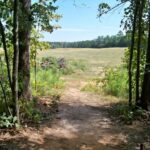Carpenter ants are insects that love to make their homes in trees. These ants can cause big problems for the tree because they like to dig tunnels and nests inside it. This makes the wood weaker and can lead to branches falling off or even the whole tree dying.
When you see carpenter ants in a tree, it’s important to take action quickly! You might notice sawdust around the base of the tree or small holes where the ants come in and out. Sometimes, you can even hear them chewing on the wood if you listen closely enough. Don’t worry though – there are ways to get rid of these pesky ants and save your tree from harm!
Identifying Carpenter Ants In Trees
Carpenter ants are a type of ant that can be found in trees. They are larger than most other ants and have dark brown or black bodies. These ants do not eat wood like termites, but instead carve out tunnels for their nests.
Carpenter ants go through a life cycle just like any other insect. They start as eggs, then turn into larvae, pupae, and finally adults. The adult carpenter ants leave the nest to find food and water, while the rest of the colony stays behind to tend to the young.
There are natural predators that help keep carpenter ant populations under control. Birds and other insects, such as spiders and beetles, will prey on these ants whenever they get the chance. However, if left unchecked, carpenter ants can cause damage to trees by hollowing out large sections inside them. Understanding the extent of this damage is important in order to properly address it.
Understanding The Damage They Can Cause
"Did you know that carpenter ants can cause serious damage to trees? It’s important to assess the risk of infestation and understand which tree species are more susceptible. Let’s take a closer look at the damage these ants can cause.
First, carpenter ants burrow into trees and create tunnels or galleries. This weakens the structure of the tree, making it more likely to fall during a storm or high winds. Additionally, as they excavate wood for their nests, they can leave piles of sawdust around the base of the tree.
Assessing the risk of carpenter ant infestations is crucial in preventing severe damage to your trees. Trees with cracks or wounds are more vulnerable, so be sure to inspect them regularly. Certain types of trees like oak, maple, and pine are also more susceptible than others. By being proactive about prevention measures such as removing deadwood and keeping your yard clean, you can help protect your trees from harm."
"Understanding the Damage They Can Cause" highlights how dangerous carpenter ants can be for trees and why it’s essential to assess risks associated with an infestation. The following section will focus on "conducting a tree inspection" where we’ll discuss steps homeowners should take to identify whether their tree has been affected by carpenter ants.
Conducting A Tree Inspection
To conduct a tree inspection, you will need some tools. These include a flashlight to see inside the trunk and branches, a ladder to reach high places, and binoculars to get a closer look at hard-to-reach areas.
It’s important to take safety measures when inspecting trees. Always wear appropriate clothing such as long pants and sleeves, gloves, and sturdy shoes with good traction. Be aware of your surroundings and watch out for falling debris or unstable branches that could cause injury.
Inspecting trees can help identify any potential issues such as carpenter ants in the tree. By taking these precautions and using the right tools, you can ensure that your inspections are safe and effective in maintaining healthy trees on your property.
To address problems like carpenter ants in the tree, using baits and traps may be necessary.
Using Baits And Traps
After conducting a thorough tree inspection, you may discover that carpenter ants have made their home in the trunk or branches. These ants can cause damage to the tree and even spread to nearby structures if left unchecked. But before resorting to applying insecticides, there are DIY options and natural alternatives that can help eliminate these pests.
One option is to use baits and traps specifically designed for carpenter ants. You can purchase these at your local hardware store or make them yourself using household items like sugar water and borax. Baits work by attracting ants with an enticing food source that has been mixed with poison. The ants then carry this back to the colony, ultimately killing off the entire population.
Another natural alternative is diatomaceous earth, which is a powder made from fossilized algae. When sprinkled around the base of the tree or on ant trails, it dehydrates and kills any insects that come into contact with it without harming beneficial organisms like bees or ladybugs.
By exploring these DIY options and natural alternatives first, you can avoid potentially harmful chemicals while still effectively controlling carpenter ant populations in trees. However, if these methods do not prove effective, it may be necessary to consider applying insecticides as a last resort solution.
As mentioned before, applying insecticides should always be considered as a last resort due to potential harm they could cause both humans and wildlife. Therefore, it’s important to consult with a professional arborist who has experience handling pesticides safely before taking this step.
Applying Insecticides
Now that we know where carpenter ants can be found, it’s time to learn about applying insecticides. This is an effective way to eliminate these pesky insects from your trees and prevent them from causing further damage. However, it’s important to choose the right product and apply it correctly.
Effective application of insecticide requires careful consideration of both the product and the target area. Look for eco friendly options that are safe for wildlife and won’t harm beneficial insects like bees or butterflies. Always read the label carefully before use and follow instructions closely. For best results, apply when temperatures are between 60-90°F and avoid spraying on windy days.
It’s also important to note that insecticides should only be used as a last resort after non-toxic methods have been exhausted. If possible, try removing infested wood first before turning to chemicals. In our next section, we’ll discuss how to safely remove infested wood without spreading the problem further.
Removing Infested Wood
If you have carpenter ants in your tree, it’s important to remove the infested wood. This will prevent further damage and keep other trees in the area safe. However, it’s also important to consider tree preservation when removing wood.
One option is to replace the infested wood with new, healthy wood. This can help maintain the structural integrity of the tree while also preventing future infestations. It’s important to choose a type of wood that is compatible with the species of tree and climate conditions in your area.
Another option is to seal off any wounds or openings in the remaining wood. This can help prevent moisture from getting inside and creating an environment for more pests to thrive. Additionally, sealing tree wounds can promote faster healing and overall health for the tree.
Sealing Tree Wounds
If you have carpenter ants in your tree, it’s important to address the issue quickly. One way to prevent further infestation is by sealing any wounds on the tree. This can be done using a method called "tree banding."
Tree banding involves wrapping a sticky material around the trunk of the tree, which prevents insects from climbing up and entering any open wounds. There are also natural remedies that can be used instead of chemical pesticides, such as diatomaceous earth or vinegar.
It’s important to note that while these methods may work for small infestations, larger ones may require consulting with a professional arborist. They will have the knowledge and tools necessary to properly assess the situation and take appropriate action.
Consulting With A Professional
I’m thinking of hiring a professional to help with a problem I have – carpenter ants in my tree. Consulting a pro will help me figure out the best solution. It’s important to get expert advice so I can get rid of the ants for good. Consulting could also help me save time, money and other resources.
Hiring A Professional
Have you noticed carpenter ants in your tree? It might be time to consult with a professional. There are many benefits to hiring someone who specializes in pest control, especially when dealing with an infestation that could potentially harm your property.
One of the major advantages of hiring a professional is their expertise and knowledge. They have experience handling different types of pests and can identify the best solution for your specific situation. While DIY methods may seem cheaper initially, they often end up costing more in the long run if the problem persists or worsens.
Of course, there will be costs associated with hiring a professional, but it’s important to consider the potential expenses without help. If left untreated, carpenter ant colonies can cause extensive damage to trees and surrounding structures. By investing in a qualified specialist now, you can save money on repairs down the line while ensuring the safety and health of your property.
Benefits Of Consulting
Now that we know the advantages of hiring a professional for pest control, let’s talk about the benefits of consulting with them. Communication is important when dealing with any problem, and it’s no different when it comes to pests. Consulting with a professional allows you to communicate your concerns and get expert recommendations tailored to your specific situation.
Expert recommendations are valuable because they provide insight into how to prevent future infestations or damage. A qualified specialist can offer advice on tree maintenance, property upkeep, and other preventative measures that can save you money in the long run. By working together, you can create a plan that addresses both current issues and potential future problems.
In conclusion, consulting with a professional not only provides expertise and knowledge but also promotes effective communication and offers expert recommendations. It’s an investment in the health and safety of your property while also potentially saving you money down the line. Don’t hesitate to reach out for help if you notice signs of carpenter ants or other pests – it’s always better to be safe than sorry!
Preventing Future Infestations
Now that you have successfully removed the carpenter ants from your tree, it’s important to take steps to prevent future infestations. Luckily, there are natural remedies and DIY solutions that can help keep these pesky pests at bay.
One effective solution is to regularly inspect your trees for signs of damage or decay. Carpenter ants are attracted to weakened wood, so keeping your trees healthy by pruning dead branches and removing any rotting stumps or logs in the surrounding area can make a big difference.
Another option is to use deterrents such as peppermint oil or vinegar spray around the base of your tree. These strong scents can repel carpenter ants and discourage them from making their home in your tree. By taking proactive measures like these, you can protect both your trees and your property from further damage caused by these destructive insects.
As you continue to care for your trees, remember to monitor their health closely. Regularly check for any signs of stress or disease and address issues promptly before they become more serious problems. This will not only help prevent future carpenter ant infestations but also ensure the long-term health and vitality of your beloved trees.
Monitoring Your Tree’s Health
Great job on taking care of your tree! As you’ve learned, trees are an important part of our environment and it’s essential to keep them healthy. Monitoring your tree’s health is crucial in maintaining its beauty and longevity. Here are some tips for monitoring your tree’s health:
- Inspect the trunk and branches regularly for any signs of decay such as cracks, holes or rotting.
- Look out for carpenter ants crawling around the tree as they may be a sign of decaying wood that needs attention.
- Check the leaves for discoloration or abnormal growth patterns that might suggest disease or pest infestation.
- Keep an eye on the soil around the base of the tree; if it remains soggy after rain, this could indicate poor drainage which can be harmful to the roots.
- Observe changes in foliage during different seasons, especially early leaf drop or delayed budding.
Pruning techniques play an integral role in keeping trees healthy by removing dead or diseased parts while promoting new growth. It is best to prune when the trees are dormant but not frozen solid as this helps minimize stress on the tree. Prune carefully with sharp tools to avoid damaging healthy bark and use safety equipment like gloves and goggles. Remember these pruning basics:
- Start at the bottom and work your way up
- Cut just outside of branch collar (where branch meets main stem)
- Remove no more than 25% of live branches
By following these simple steps, you will ensure that your tree stays strong and vibrant for many years to come. So get out there, monitor your tree’s health regularly, take note of any changes you see throughout the year, and don’t forget about proper pruning techniques!
Frequently Asked Questions
How Do Carpenter Ants Affect The Ecosystem Of Trees?
Carpenter ants can have a big impact on the ecosystem of trees. They play an important role in forest regeneration by helping to break down dead wood and recycle nutrients back into the soil. However, if there are too many carpenter ants in one area, they can also disrupt the balance of biodiversity by competing with other insects for resources. It’s important to keep an eye on carpenter ant populations and make sure they’re not causing too much damage to our forests.
Can Carpenter Ants Infest Any Type Of Tree Or Do They Prefer Certain Species?
Many insects can affect tree health, including carpenter ants. Insect behavior plays a big role in the types of trees they prefer to infest. Some species of ants may be attracted to certain types of trees because of the moisture content or type of wood. Other factors that may influence their choice include the availability of food sources and shelter. It is important for homeowners and gardeners to monitor the health of their trees regularly to prevent insect infestations from causing long-term damage.
Are There Any Natural Remedies Or Diy Solutions To Getting Rid Of Carpenter Ants In Trees?
If you have ants in your backyard and want to get rid of them without harming the environment, then there are some DIY solutions and natural remedies that you can try. You could mix equal parts of borax and sugar, spread it around where the ants are located, and wait for them to carry it back to their colony. Another option is placing cucumber slices or citrus peels near the ant trails since they cannot stand the smell of these foods. Additionally, boiling water poured over an anthill can be effective as well. These methods may not work as quickly as chemical pesticides, but they are safer for the ecosystem!
Can Carpenter Ants Cause Structural Damage To Buildings Or Other Structures Near Infested Trees?
Carpenter ants can cause damage to neighboring properties if they infest trees nearby. These ants are known for burrowing into wood, which weakens the structure of both trees and buildings. If left untreated, this can lead to serious structural problems that require expensive repairs. It’s important to address any carpenter ant infestations as soon as possible to prevent further damage. Additionally, an infestation in a tree can also have negative effects on the health of the tree itself.
What Is The Lifespan Of A Carpenter Ant Colony In A Tree And How Quickly Can They Spread To Other Nearby Trees?
Carpenter ants can live for a few years in their colony. The lifespan of the colony depends on various factors like temperature and food availability. When carpenter ants are ready to disperse, they send out winged individuals called alates who fly away from the nest and start new colonies. Carpenter ant colonies can grow quickly if there is enough space and resources available nearby. This means that they could spread to other trees relatively fast!
Conclusion
In conclusion, carpenter ants in trees can have a big impact on the ecosystem. They like to make their homes inside of dead or decaying wood, which can cause problems for the tree’s health. These ants are not picky and will infest any type of tree they find suitable.
If you discover carpenter ants in your tree, there are natural remedies that you can try before calling an exterminator. These include using vinegar and water sprays, diatomaceous earth powder, or boric acid bait stations. However, if the infestation is severe or close to nearby structures, it may be best to seek professional help.
Overall, it’s important to keep an eye out for carpenter ant colonies in trees as they can quickly spread and potentially cause damage to surrounding areas. With proper care and attention to our environment, we can work towards maintaining healthy ecosystems for all living creatures.



